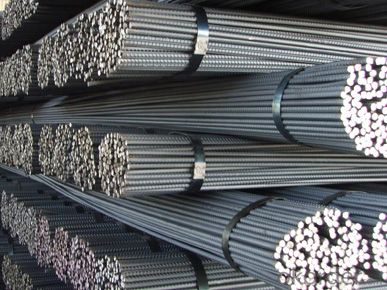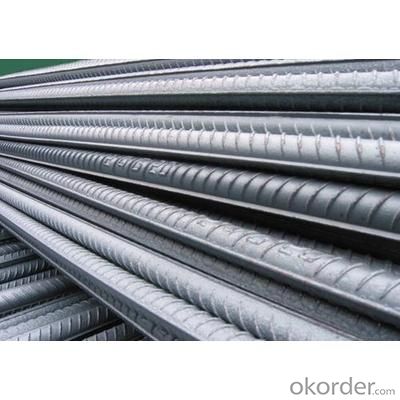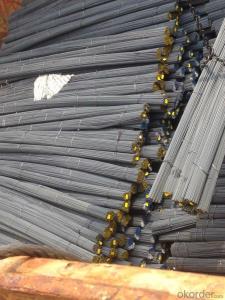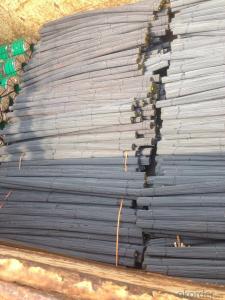Deformed Steel Bar for Construction, High Quality Deformed Bar
- Loading Port:
- Tianjin
- Payment Terms:
- TT OR LC
- Min Order Qty:
- 50 m.t.
- Supply Capability:
- 200000 m.t./month
OKorder Service Pledge
OKorder Financial Service
You Might Also Like
Item specifice
Product Description of Deformed Steel Bar for Construction, High Quality Deformed Bar:
OKorder is offering Deformed Steel Bar for Construction, High Quality Deformed Bar great prices with worldwide shipping. Our supplier is a world-class manufacturer of steel, with our products utilized the world over. OKorder annually supplies products to European, North American and Asian markets. We provide quotations within 24 hours of receiving an inquiry and guarantee competitive prices.
Product Applications of Deformed Steel Bar for Construction, High Quality Deformed Bar:
Deformed Steel Bar for Construction, High Quality Deformed Bar are ideal for structural applications and are widely used in the construction of buildings and bridges, and the manufacturing, petrochemical, and transportation industries.
Product Advantages of Deformed Steel Bar for Construction, High Quality Deformed Bar:
OKorder's Deformed Steel Bar for Construction, High Quality Deformed Bar are durable, strong, and resist corrosion.
Main Product Features of Deformed Steel Bar for Construction, High Quality Deformed Bar:
· Premium quality
· Prompt delivery & seaworthy packing (30 days after receiving deposit)
· Corrosion resistance
· Can be recycled and reused
· Mill test certification
· Professional Service
· Competitive pricing
Product Specifications of Deformed Steel Bar for Construction, High Quality Deformed Bar:
Standard | GB | HRB400 | |
Diameter | 6mm,8mm,10mm,12mm,14mm,16mm,18mm,20mm, 22mm,25mm,28mm,32mm,36mm,40mm,50mm | ||
Length | 6M, 9M,12M or as required | ||
Place of origin | Hebei, China mainland | ||
Advantages | exact size, regular package, chemical and mechanical properties are stable. | ||
Type | Hot rolled deformed steel bar | ||
Brand name | DRAGON | ||
Chemical Composition: (Please kindly find our chemistry of our material based on HRB500 as below for your information)
Grade | Technical data of the original chemical composition (%) | ||||||
C | Mn | Si | S | P | V | ||
HRB400 | ≤0.25 | ≤1.60 | ≤0.80 | ≤0.045 | ≤0.045 | 0.04-0.12 | |
Physical capability | |||||||
Yield Strength (N/cm²) | Tensile Strength (N/cm²) | Elongation (%) | |||||
≥400 | ≥570 | ≥14 | |||||
Theoretical weight and section area of each diameter as below for your information:
Diameter(mm) | Section area (mm²) | Mass(kg/m) | Weight of 12m bar(kg) |
6 | 28.27 | 0.222 | 2.664 |
8 | 50.27 | 0.395 | 4.74 |
10 | 78.54 | 0.617 | 7.404 |
12 | 113.1 | 0.888 | 10.656 |
14 | 153.9 | 1.21 | 14.52 |
16 | 201.1 | 1.58 | 18.96 |
18 | 254.5 | 2.00 | 24 |
20 | 314.2 | 2.47 | 29.64 |
22 | 380.1 | 2.98 | 35.76 |
25 | 490.9 | 3.85 | 46.2 |
28 | 615.8 | 4.83 | 57.96 |
32 | 804.2 | 6.31 | 75.72 |
36 | 1018 | 7.99 | 98.88 |
40 | 1257 | 9.87 | 118.44 |
50 | 1964 | 15.42 | 185.04 |
Usage and Applications of Deformed Steel Bar for Construction, High Quality Deformed Bar:
Deformed bar is widely used in buildings, bridges, roads and other engineering construction. Big to highways, railways, bridges, culverts, tunnels, public facilities such as flood control, dam, small to housing construction, beam, column, wall and the foundation of the plate, deformed bar is an integral structure material. With the development of world economy and the vigorous development of infrastructure construction, real estate, the demand for deformed bar will be larger and larger..
Packaging & Delivery of Deformed Steel Bar for Construction, High Quality Deformed Bar:
Packaging Detail: products are packed in bundle and then shipped by container or bulk vessel, deformed bar is usually naked strapping delivery, when storing, please pay attention to moisture proof. The performance of rust will produce adverse effect.
Each bundle weight: 2-3MT, or as required
Payment term: TT or L/C
Delivery Detail: within 45 days after received advanced payment or LC.
Label: to be specified by customer, generally, each bundle has 1-2 labels
Trade terms: FOB, CFR, CIF
Images of Deformed Steel Bar for Construction, High Quality Deformed Bar:
I

Note:
1. Our products are produced according to national standard (GB), if not, supply according to national standards (GB) or agreement as customer required.
2. Other Grade and Standard Deformed Steel Bar we can supply:
Grade: GR40/GR60, G460B/B500A/B500B/B500C,BST500S
Standard: ASTM, BS, DIN
The Minimum Order Quantity of these products is high, and need to be confirmed.
3. We can not only supply Deformed Steel Bar; if you need anything about building materials, please contact us for further information.
4. Please send us your detail specifications when inquire. We will reply to you as soon as possible. We sincerely hope we can establish a long stable business relationship.
FAQ:
Are you a trading company or manufacturer? | Manufacturer |
What’s the MOQ? | 3 metric ton |
What’s your delivery time? | 15-35 days after downpayment received |
Do you Accept OEM service? | Yes |
what’s your delivery terms? | FOB/CFR/CIF |
What's the Payment Terms? | 30% as deposit,70% before shipment by T/T |
Western Union acceptable for small amount. | |
L/C acceptable for large amount. | |
Scrow ,Paybal,Alipay are also ok | |
Why choose us? | Chose happens because of quality, then price, We can give you both. Additionally, we can also offer professional products inquiry, products knowledge train (for agents), smooth goods delivery, excellent customer solution proposals. |
What's your available port of Shipment? | Main Port, China |
What’s your featured services? | Our service formula: good quality+ good price+ good service=customer's trust
|
Where are your Market? | Covering more than 160 countries in the world |
- Q:Can steel rebars be used in residential foundation construction?
- Yes, steel rebars can be used in residential foundation construction. Steel rebars provide reinforcement and strength to concrete, making them an essential component in the construction of residential foundations.
- Q:What are the guidelines for reinforcing concrete slabs with steel rebars?
- The guidelines for reinforcing concrete slabs with steel rebars involve several key considerations. Firstly, it is important to determine the required amount of reinforcement based on the load that the slab will be subjected to. This load can be calculated using structural engineering principles and taking into account factors such as the intended use of the slab, the weight of any equipment or vehicles that will be placed on it, and any applicable building codes or regulations. Once the required amount of reinforcement is determined, the next step is to design the layout of the rebars. This involves spacing the rebars at specified intervals to ensure uniform distribution of the load across the slab. The spacing will depend on the thickness of the slab, with thicker slabs generally requiring a greater number of rebars. Additionally, it is important to include minimum clearances between the rebars and the edges or bottom of the slab to prevent corrosion and ensure proper concrete cover. The size and type of rebars used is also an important consideration. Commonly used types include plain round bars, deformed bars, or welded wire fabric. The diameter of the rebars and the grade of steel should be selected based on the expected load and the requirements of the project specifications or building codes. During the construction process, it is crucial to properly place and secure the rebars within the formwork to maintain their intended position. This may involve the use of chairs, spacers, or other devices to ensure proper alignment and prevent displacement. Additionally, care should be taken to avoid any damage to the rebars during the concrete pouring and finishing process. Finally, it is important to inspect and test the reinforced concrete slab to ensure that the rebars are properly installed and meet the required specifications. This may involve visual inspections, as well as non-destructive testing methods such as ultrasound or ground-penetrating radar to verify the integrity and position of the rebars. Overall, following these guidelines for reinforcing concrete slabs with steel rebars will help to ensure the structural integrity and longevity of the slab, while also meeting the necessary safety and building code requirements.
- Q:What is the maximum length of a steel rebar?
- The maximum length of a steel rebar can vary depending on several factors such as the specific project requirements, transportation limitations, and manufacturing capabilities. In general, steel rebars are commonly available in lengths ranging from 20 feet (6 meters) to 60 feet (18 meters). However, longer lengths can be achieved through specialized fabrication techniques, such as welding or splicing, which allow for the connection of multiple rebars to create longer lengths as needed. It is important to consult with structural engineers, architects, and construction professionals to determine the appropriate length of steel rebars for a specific project, considering factors such as structural integrity, safety, and logistics.
- Q:What are the guidelines for the proper spacing of steel rebars in beams?
- The guidelines for the proper spacing of steel rebars in beams are determined by engineering standards and codes. These guidelines ensure the structural integrity and strength of the beam. Here are some general guidelines to consider: 1. Rebar spacing: The spacing between rebars should be such that it allows for proper concrete placement and consolidation. Typically, the spacing is measured in terms of rebar diameter or as a percentage of the beam depth. The specific spacing requirements may vary based on factors such as the beam size, load requirements, and design specifications. 2. Minimum and maximum spacing: There are usually minimum and maximum spacing requirements for rebars in beams. The minimum spacing ensures proper concrete cover around the rebar to protect it from corrosion and provide fire resistance. The maximum spacing helps in distributing the loads evenly and prevents excessive cracking of the concrete. 3. Concrete cover: The rebars should be adequately covered by concrete to provide protection against corrosion and provide fire resistance. The concrete cover is the distance between the outer surface of the rebar and the edge of the beam. The required concrete cover is specified in engineering codes and is based on factors such as exposure conditions, durability requirements, and fire ratings. 4. Spacing around supports and openings: Special attention should be given to the spacing of rebars around supports such as columns and walls, as well as around openings like doorways or windows. These areas may experience higher stresses and require additional reinforcement. Engineering codes provide specific requirements for these situations, taking into account the size and shape of the supports or openings. 5. Lateral and longitudinal reinforcement: In addition to the spacing of rebars along the length of the beam (longitudinal reinforcement), beams may require additional reinforcement in the form of stirrups or ties (lateral reinforcement). These elements provide resistance against shear forces and help in preventing diagonal cracking. The spacing and size of these additional reinforcement elements are determined based on the design requirements and load conditions. It is important to note that the specific guidelines for spacing of steel rebars in beams may vary depending on regional building codes, project specifications, and engineering standards. Therefore, it is crucial to consult with a qualified structural engineer or refer to the applicable building codes and design documents for accurate and up-to-date guidelines.
- Q:What is the cost of steel rebars?
- The cost of steel rebars can vary depending on factors such as the size, grade, quantity, and location of purchase. It is recommended to contact suppliers or check with local construction material stores for accurate and up-to-date pricing information.
- Q:How do steel rebars prevent cracking in concrete structures?
- Steel rebars prevent cracking in concrete structures by providing tensile strength to the concrete. As concrete is strong in compression but weak in tension, the rebars act as a reinforcement by absorbing the tensile forces and distributing them throughout the structure. This helps to resist cracking and increase the overall durability and strength of the concrete structure.
- Q:What is the role of steel rebars in maintaining structural integrity?
- Steel rebars play a crucial role in maintaining structural integrity by reinforcing and strengthening concrete structures. They provide tensile strength to resist cracking, bending, and shearing forces, enhancing the overall stability and durability of buildings, bridges, and other infrastructure.
- Q:Are there any alternatives to steel rebars in construction?
- Yes, there are several alternatives to steel rebars in construction. Some common alternatives include fiber-reinforced polymer (FRP) rebars, basalt rebars, and glass fiber-reinforced polymer (GFRP) rebars. These alternatives offer advantages such as high corrosion resistance, lightweight, and improved durability while maintaining similar or better structural properties compared to steel rebars. However, the choice of alternative rebars depends on factors such as cost, specific project requirements, and local building codes and regulations.
- Q:Can steel rebars be welded or spliced together?
- Yes, steel rebars can be welded or spliced together. Welding is a common method used to join steel rebars together. It involves heating the rebars to a high temperature and then using a welding electrode to melt the steel and create a strong bond between the rebars. Welding is often used in construction projects where a continuous reinforcement is required. Splicing, on the other hand, involves connecting two rebars using mechanical connectors or couplers. These connectors are designed to provide a strong and reliable connection between the rebars. Splicing is often used when rebars need to be extended or when there is a need to join different rebars together. Both welding and splicing methods have their advantages and disadvantages. Welding provides a continuous reinforcement and creates a strong bond between the rebars, but it requires skilled labor and can be time-consuming. Splicing, on the other hand, is quicker and easier to perform, but it may result in a slight reduction in the overall strength of the reinforcement. It is important to note that the use of welding or splicing for steel rebars should comply with the relevant codes and standards, as well as be approved by the structural engineer or the responsible authority.
- Q:How are steel rebars specified in construction drawings?
- Steel rebars are typically specified in construction drawings by indicating their size, shape, and spacing, along with any specific requirements such as grade or coating. This information is usually provided through symbols, labels, or callouts on the drawings.
1. Manufacturer Overview |
|
|---|---|
| Location | |
| Year Established | |
| Annual Output Value | |
| Main Markets | |
| Company Certifications | |
2. Manufacturer Certificates |
|
|---|---|
| a) Certification Name | |
| Range | |
| Reference | |
| Validity Period | |
3. Manufacturer Capability |
|
|---|---|
| a)Trade Capacity | |
| Nearest Port | |
| Export Percentage | |
| No.of Employees in Trade Department | |
| Language Spoken: | |
| b)Factory Information | |
| Factory Size: | |
| No. of Production Lines | |
| Contract Manufacturing | |
| Product Price Range | |
Send your message to us
Deformed Steel Bar for Construction, High Quality Deformed Bar
- Loading Port:
- Tianjin
- Payment Terms:
- TT OR LC
- Min Order Qty:
- 50 m.t.
- Supply Capability:
- 200000 m.t./month
OKorder Service Pledge
OKorder Financial Service
Similar products
New products
Hot products
Related keywords





























